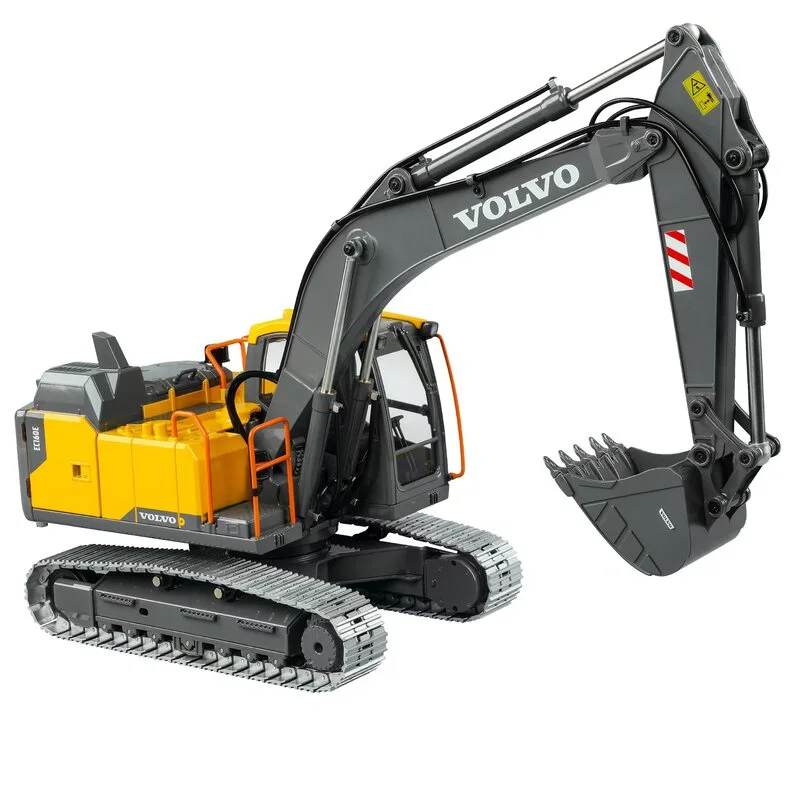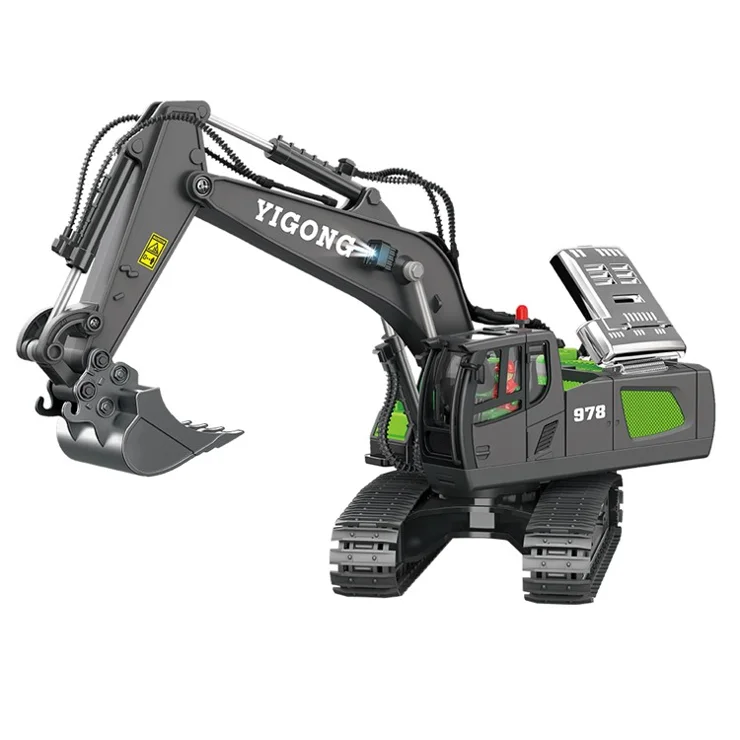The Essential Features of Excavator That Keep It a Must-Have Tool
Excavators are important in the building and construction and landscaping markets. Their functional attachments enable a series of jobs, from excavating to demolition. In addition, they flaunt remarkable excavating depth and reach, powered by durable engines. Operator comfort and compact designs enhance usability in different environments. What genuinely establishes excavators apart are their innovative hydraulic systems and longevity. Understanding these attributes can clear up why they are considered necessary devices on any task site.
Flexible Add-ons for Enhanced Performance
Excavators are powerful machines on their very own, the addition of functional add-ons considerably enhances their functionality. These attachments change a common excavator right into a multi-purpose device, ideal for a selection of tasks. Buckets, as an example, come in numerous sizes and shapes, allowing operators to dig, scoop, and move products effectively. Hydraulic thumbs can be included for improved gripping and handling of large products, such as logs or rocks.Furthermore, specialized accessories like breakers and augers enable for exploration and demolition job, expanding the excavator's energy on construction sites. remote control excavator. Grapples are another option, suitable for sorting and moving particles. This versatility not just raises efficiency yet also lowers the requirement for multiple devices, conserving time and prices. By equipping excavators with the right attachments, drivers can take on diverse jobs, making them crucial in the building and construction market
Superior Digging Deepness and Get To
Excavators are made with remarkable digging depth and reach, enabling them to steer in tight areas and access hard-to-reach locations. This capacity is critical for various building and excavation tasks, where typical equipment may drop short. With adjustable boom arms and extendable tracks, excavators can quickly browse irregular surface while maintaining stability.The digging depth can vary substantially among versions, often ranging from 10 to 25 feet, relying on the style and function. This function makes it possible for operators to dig deep into structures, trenches, and various other deep frameworks efficiently. In addition, the reach of an excavator permits specific excavating and product handling without repositioning the equipment frequently, conserving time and labor costs.Ultimately, the premium excavating depth and reach of excavators make them important for specialists looking for to finish complex jobs with accuracy and effectiveness. Their convenience boosts efficiency on task sites, showcasing them as a necessary device in contemporary building.
Powerful Engine Performance

When it involves effectiveness and efficiency on building websites, effective engine efficiency plays a critical role in the capabilities of an excavator. A durable engine creates substantial horse power, allowing the maker to deal with heavy-duty jobs effortlessly - remote control excavator. This toughness translates into faster cycle times, allowing operators to total projects a lot more quickly.Additionally, effective engines offer the required torque to handle difficult surfaces and varied loads, making certain that the excavator can execute successfully under various problems. Whether it is lifting, excavating, or relocating materials, the engine's efficiency straight impacts the general functional effectiveness of the machine.Furthermore, developments in engine modern technology have led to enhanced gas efficiency, decreasing functional costs while preserving power result. Inevitably, the engine's efficiency works as the foundation of an excavator, affirming its condition as an essential device in the building and construction industry
Advanced Hydraulic Systems

Boosted Raising Ability
A considerable enhancement in lifting ability can be attributed to sophisticated hydraulic systems discovered in modern-day excavators. These systems make use of high-pressure liquid to create better pressure, permitting drivers to raise larger loads with simplicity. The design behind these hydraulics assurances peak efficiency, giving an excellent power-to-weight proportion that boosts total efficiency. Therefore, excavators can tackle requiring jobs, such as raising big materials or devices, without compromising security. Additionally, the durable layout of hydraulic elements adds to enhanced longevity and dependability, making them suitable for various construction environments. This boosted training ability not only lowers the time required for tasks however also decreases the demand for additional machinery, confirming necessary for both productivity and cost-effectiveness in the building sector.
Enhanced Accuracy Control
Traditional excavators often struggled with accuracy, modern hydraulic systems have actually transformed control mechanisms, allowing operators to execute jobs with impressive precision. These innovative systems utilize proportional control valves that enable for smoother and more responsive important link movements, substantially reducing the margin for error. Operators can now finely tune the excavator's movements, making it easier to browse limited rooms and handle delicate products. Enhanced comments systems even more inform drivers of real-time efficiency, guaranteeing optimal sychronisation in between the maker and operator. This boosted accuracy not only boosts performance however additionally enhances security on work sites, lessening the danger of mishaps. Therefore, modern-day excavators outfitted with advanced hydraulic systems are invaluable devices for building and construction and excavation jobs calling for precise precision.
Driver Comfort and Exposure
Operator comfort and presence are essential elements in the style of contemporary excavators (remote control excavator). Attributes such as ergonomic seat layout, improved exposure alternatives, and efficient control formats considerably improve the driver's experience and productivity. Focusing on these aspects guarantees that drivers can work properly and securely in numerous problems
Ergonomic Seat Style
Convenience and presence are critical in excavator style, with the ergonomic seat playing an important function in enhancing the driver's experience. An ergonomic seat is crafted to support the operator's body, reducing tiredness during long hours of procedure. Flexible features, such as seat elevation, backrest angle, and lumbar assistance, satisfy individual choices and advertise excellent stance. These modifications boost convenience and allow the operator to preserve concentrate on tasks without discomfort. Additionally, a properly designed seat can give much better lateral assistance, permitting smoother handling when the excavator is in procedure. This thoughtful layout not only enhances performance however also adds to overall safety, guaranteeing that drivers can do their tasks effectively and successfully.
Boosted Exposure Functions
The layout of an excavator expands beyond simply the seat, with improved exposure attributes playing a substantial role in operator convenience and overall safety. Large windows and strategically positioned mirrors give drivers with a clear sight of their environments, reducing unseen areas. This style factor to consider permits far better spatial recognition, which is necessary in active workplace. Furthermore, several excavators integrate rearview cameras and progressed surveillance find this systems that aid drivers in navigating tight spaces. The assimilation of these presence includes not just promotes safety but likewise reduces operator tiredness by making it possible for simpler monitoring of workplace. Ultimately, boosted presence contributes to more efficient operations and helps guarantee that excavators can perform their jobs efficiently and securely.
Control Format Effectiveness
While handling facility job sites, a reliable control format greatly enhances both driver comfort and exposure. A well-designed control configuration guarantees that operators can access necessary features with minimal effort, minimizing fatigue throughout long hours. Ergonomic joystick placements and user-friendly button plans enable for smooth operation, enabling drivers to keep concentrate on the task available. Additionally, clear presence of both the work location and the control panel is critical for safety and security and accuracy. Modern excavators typically include adjustable seating and control settings to accommodate various operator preferences, additionally improving convenience. Inevitably, a thoughtfully designed control design not just enhances productivity yet also promotes a safer working atmosphere by permitting operators to respond quickly to changing conditions.
Compact Design for Urban Environments
As city construction websites commonly face area restrictions, a small layout comes to be necessary for excavators running in these atmospheres. These equipments are engineered to browse limited rooms, permitting reliable maneuverability in jampacked job sites. A lowered impact enables them to function carefully to existing structures, decreasing disturbance and optimizing productivity.The small style typically includes shorter tracks and a tighter turning distance, helping with operation in narrow alleys and restricted areas. In addition, light-weight materials contribute to alleviate of transportation, making it easier to relocate the excavator from one place to one more within the metropolitan landscape.Additionally, lots of compact excavators are equipped with features such as functional add-ons and extendable arms, boosting their capability while keeping a tiny dimension. This flexibility enables operators to take on a range of tasks, from excavating to demolition, all while suitable perfectly into the restrictions of city atmospheres.

Resilience and Upkeep Considerations
Longevity stands as an essential aspect in the performance and longevity of excavators, specifically in requiring metropolitan atmospheres. These machines are subjected to strenuous problems, including differing dirt types, extreme temperatures, and high-frequency use. Top notch materials and durable building are necessary for making certain that excavators can stand up to these challenges without jeopardizing functionality.Regular maintenance is just as essential in maintaining resilience. Arranged inspections, prompt oil modifications, and the replacement of used components add considerably to an excavator's life expectancy. Operators must additionally pay interest to hydraulic systems, tracks, and undercarriages, as these parts often birth the force of wear and tear.Investing in durable excavators with extensive upkeep strategies enhances dependability and decreases downtime, eventually bring about increased efficiency on construction websites. Recognizing the interaction between resilience and upkeep is crucial for anyone thinking about the purchase of an excavator for metropolitan jobs.
Regularly Asked Concerns
How Do Excavators Contrast to Various Other Building And Construction Devices?
Excavators stick out amongst construction equipment because of their adaptability, enabling tasks such as grading, excavating, and lifting. Contrasted to others, their hydraulic capabilities offer greater efficiency and power, making them important on different task sites.
What Safety Features Are Consisted Of in Modern Excavators?
Modern excavators include different safety features, including rollover protection systems, alarm systems, and progressed exposure enhancements. These aspects work with each other to decrease dangers, ensuring driver safety and security while improving effectiveness on building sites and other demanding atmospheres.

Can Excavators Be Made Use Of in Winter Conditions?
Excavators can indeed be used in winter season conditions, provided they are geared up with suitable winter accessories and safety measures are taken. Proper upkeep and modifications boost their efficiency, making certain reliable procedure despite challenging weather situations.
What Is the Average Life-span of an Excavator?
The typical life expectancy of an excavator generally varies from 7,000 to 10,000 hours of procedure. This duration can greatly rely on maintenance techniques, running conditions, and the details design's sturdiness and design attributes.
Exactly how Do I Select the Right Excavator Dimension for My Job?
Choosing the right excavator dimension involves examining view publisher site project extent, site problems, and material types. Consider factors like reach, deepness requirements, and weight capacity to guarantee maximum efficiency and security during procedure. Size issues significantly in project success. In addition, the reach of an excavator allows for exact excavating and material handling without rearranging the machine frequently, conserving time and labor costs.Ultimately, the superior digging depth and reach of excavators make them indispensable for specialists seeking to complete intricate tasks with accuracy and performance. Comfort and presence are paramount in excavator style, with the ergonomic seat playing an essential function in boosting the driver's experience. The style of an excavator expands beyond simply the seat, with boosted visibility functions playing a substantial role in operator convenience and total safety. Modern excavators commonly include adjustable seating and control settings to fit different operator choices, better enhancing comfort. Light-weight products add to reduce of transport, making it less complex to relocate the excavator from one area to another within the urban landscape.Additionally, numerous compact excavators are geared up with functions such as extendable arms and flexible add-ons, improving their capability while preserving a small size.